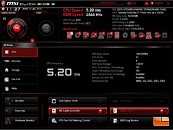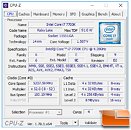Monday, January 16th 2017

MSI Z270 Motherboards Automate Core i7-7700K Overclock to 5.20 GHz
The "Game Boost" overclock automation feature the UEFI setup program of MSI Z270 motherboards, apparently is successful in overclocking Core i7-7700K processors to 5.20 GHz with liquid CPU cooling. Most motherboard vendors include some degree of automated overclocking with their motherboards, which let overclocking novices squeeze a little bit of extra performance out of their CPU and memory without having to tinker with settings they know nothing about. These technologies use automated trial-and-error overclocking and stability testing over multiple reboots, to achieve a somewhat high overclock setting that takes system stability and temperatures into account.
The highest automated overclock setting of MSI "Game Boost" within its UEFI setup program of the company's Z270 XPower Gaming Titanium motherboard is having success in getting the CPU to run at 5.20 GHz. The program presents the user with 11 grades of overclock. At its highest grade, the program pushes the CPU all the way to 5.20 GHz, with 52x 100 MHz multiplier/base-clock setting, a vCore voltage of 1.507V, vDIMM of 1.2V, and disabled C-states. Keeping this overclock stable, however, took AIO liquid CPU cooling.
Source:
LegitReviews
The highest automated overclock setting of MSI "Game Boost" within its UEFI setup program of the company's Z270 XPower Gaming Titanium motherboard is having success in getting the CPU to run at 5.20 GHz. The program presents the user with 11 grades of overclock. At its highest grade, the program pushes the CPU all the way to 5.20 GHz, with 52x 100 MHz multiplier/base-clock setting, a vCore voltage of 1.507V, vDIMM of 1.2V, and disabled C-states. Keeping this overclock stable, however, took AIO liquid CPU cooling.


57 Comments on MSI Z270 Motherboards Automate Core i7-7700K Overclock to 5.20 GHz
Usually it can have mild effect, like need to drop off hundred MHz core clock after a while, but when it really starts to go it will go there is no stopping.
It is real physical phenomenon, seen it multiple times with my own chips. Especially bad when combined with high temperatures (which there will be at that voltage).
You'd be far better off running that 100 - 200MHz lower clock speed at reasonable voltages pretty much indefinitely compared to doing so for some time, possibly ending up having to use even lower OC afterwards. 1.52V is indeed absolute maximum rating (do you really want to be running at that extended time?), wanna bet your motherboard isn't pushing even more in reality? Gaming/OC motherboards are notorious for giving CPU more voltage than software is telling.
Earlier, you must have been talking about something else I guess, where you did see this happening 'a ton'. I assume that when you said, "at even less voltage" you were talking about 'reasonable' voltages...... I guess you run at unreasonable voltages?Forgot to comment on this earlier....
... just check. Use CPUz or other tools to verify. Typically, at least Z170 and down, with manual overclocking, its either spot on or there is the Intel spec, vdroop (less on load). But, when overclocking, you are looking at the voltages anyway... at least you should, and all good guides tell you this.